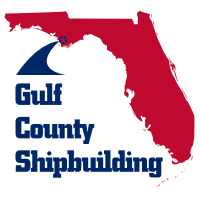History
The Gulf County Shipbuilding shipyard site is located on a site that had previously been owned by the St. Joe Corporation and its predecessors since before 1940. (St. Joe Corporation actually owned most of the land in Gulf County). For the majority of this time the land was undeveloped. Later it was used to grow and harvest timber.
The site was partially developed in the late 1950s as a loading dock, primarily for the loading of dynamite and electric blasting caps. The dynamite and the caps were manufactured in different states, transported to the dock in trailers, and loaded on to a barge. The shipments came from Missouri, Alabama, and Pennsylvania.
Here the dynamite has been hand loaded onto the pallet and is being covered for the transport onto the larger ship. Photo Credit: Captain David Maddox.
The entire trucking trailer was loaded onto the barge by backing the trailer over a loading platform and directly onto the barge. The barge was then tug assisted to one of two anchorages off the coast where larger ships that were unable to travel up the canal to the loading dock awaited the shipment.
Here the barge is seen along side of the awaiting vessel. The tugboat used to maneuver the barge is in the foreground.
The closer of the two anchorages was limited to 250 tons of explosive cargo. The more distant of the two anchorages would accommodate vessels carrying more than 250 tons of explosive materials. The name of the company that operated the tugboats was Gulf Towing Company. Once the barge was along side the larger vessel, the dynamite was then unloaded from the trucks by hand onto a pallet seated on a dolly. The pallet could then be lifted onto the larger vessel.
Here the dynamite is being loaded by hand onto the pallet and dolly. Photo Credit: Captain David Maddox
The arrangement of the trailers on the barge is how they were driven directly on to the barge at the dock. The barges current position is where the dynamite was unloaded onto pallets and then onto the ship. Photo Credit: Captain David Maddox
The location of the site was chosen for loading dynamite because of remote characteristics and waterway accessibility. The 2 anchorage areas for the larger vessels may be observed on current navigational charts and are located well away from populated areas. Shipping destinations for the material included Columbia, South America, where it was used for oil exploration and the construction of roadways.
Here the conveyor used to unload the dynamite and the storage of the dynamite in the trailer until the barge is along side the larger vessel is seen Photo credit: Captain David Maddox.
The loading facility employed approximately 3-6 persons. No onsite equipment was necessary. The trailers were loaded directly onto the barge; therefore the cargo was never unloaded at the loading dock during the transaction. The only fixed structures on the site consisted of two guard shacks to allow the guards to be sheltered from the environment. No maintenance of any kind was performed on any of the vehicles at the site.
The two anchorages off the coast of Port St. Joe are illustrated in this navigational chart. The mouth of the Gulf County Canal is seen at the top of the chart. The loading facility is up the Gulf County Canal.
The cleared site is composed of approximately 4 acres, with a berm built up to shield the outside area from the loading dock. A steel dock was constructed to berth the barge and provide a loading platform. There are currently remnants of the loading dock that are heavily corroded and will not be used by Gulf County Shipbuilding. The loading dock was in operation for less than a three-year period. Until now, there have been no other registered industrial, commercial, or residential uses of the property since the dynamite loading dock facility was moved to King’s Bay, Georgia.
Gulf County Shipbuilding would like to extend our sincerest thanks to Capt. David Maddox for is help in compiling this information. Mr. Maddox is a 3rd generation Harbor Pilot for Port St. Joe and St. Joseph’s Bay. He became involved in Piloting in 1938 as an apprentice and was the official Florida State licensed Pilot for the area from 1946 to 1991. During the time that the dynamite dock loading facility was in operation, Mr. Maddox owned the towing company that operated the tugboats involved in the operation.





